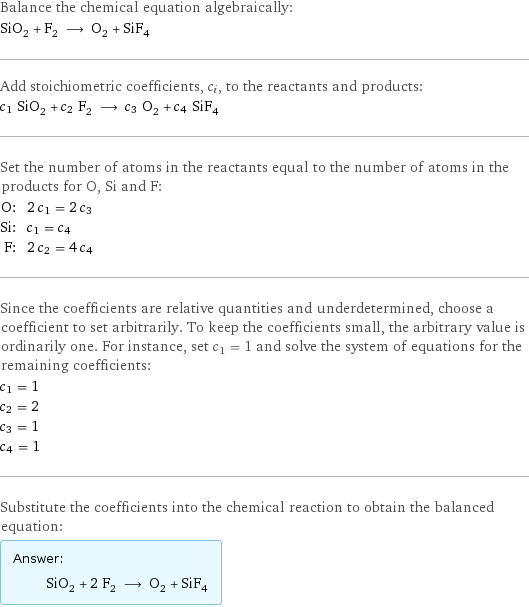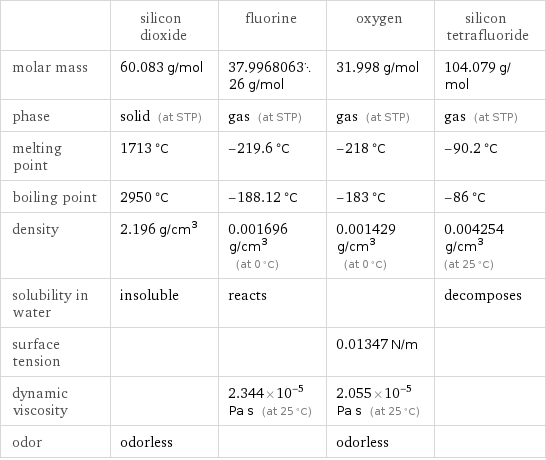Input interpretation

SiO_2 (silicon dioxide) + F_2 (fluorine) ⟶ O_2 (oxygen) + SiF_4 (silicon tetrafluoride)
Balanced equation

Balance the chemical equation algebraically: SiO_2 + F_2 ⟶ O_2 + SiF_4 Add stoichiometric coefficients, c_i, to the reactants and products: c_1 SiO_2 + c_2 F_2 ⟶ c_3 O_2 + c_4 SiF_4 Set the number of atoms in the reactants equal to the number of atoms in the products for O, Si and F: O: | 2 c_1 = 2 c_3 Si: | c_1 = c_4 F: | 2 c_2 = 4 c_4 Since the coefficients are relative quantities and underdetermined, choose a coefficient to set arbitrarily. To keep the coefficients small, the arbitrary value is ordinarily one. For instance, set c_1 = 1 and solve the system of equations for the remaining coefficients: c_1 = 1 c_2 = 2 c_3 = 1 c_4 = 1 Substitute the coefficients into the chemical reaction to obtain the balanced equation: Answer: | | SiO_2 + 2 F_2 ⟶ O_2 + SiF_4
Structures

+ ⟶ +
Names

silicon dioxide + fluorine ⟶ oxygen + silicon tetrafluoride
Reaction thermodynamics
Gibbs free energy

| silicon dioxide | fluorine | oxygen | silicon tetrafluoride molecular free energy | -856 kJ/mol | 0 kJ/mol | 231.7 kJ/mol | -1573 kJ/mol total free energy | -856 kJ/mol | 0 kJ/mol | 231.7 kJ/mol | -1573 kJ/mol | G_initial = -856 kJ/mol | | G_final = -1341 kJ/mol | ΔG_rxn^0 | -1341 kJ/mol - -856 kJ/mol = -485.1 kJ/mol (exergonic) | | |
Equilibrium constant
![Construct the equilibrium constant, K, expression for: SiO_2 + F_2 ⟶ O_2 + SiF_4 Plan: • Balance the chemical equation. • Determine the stoichiometric numbers. • Assemble the activity expression for each chemical species. • Use the activity expressions to build the equilibrium constant expression. Write the balanced chemical equation: SiO_2 + 2 F_2 ⟶ O_2 + SiF_4 Assign stoichiometric numbers, ν_i, using the stoichiometric coefficients, c_i, from the balanced chemical equation in the following manner: ν_i = -c_i for reactants and ν_i = c_i for products: chemical species | c_i | ν_i SiO_2 | 1 | -1 F_2 | 2 | -2 O_2 | 1 | 1 SiF_4 | 1 | 1 Assemble the activity expressions accounting for the state of matter and ν_i: chemical species | c_i | ν_i | activity expression SiO_2 | 1 | -1 | ([SiO2])^(-1) F_2 | 2 | -2 | ([F2])^(-2) O_2 | 1 | 1 | [O2] SiF_4 | 1 | 1 | [SiF4] The equilibrium constant symbol in the concentration basis is: K_c Mulitply the activity expressions to arrive at the K_c expression: Answer: | | K_c = ([SiO2])^(-1) ([F2])^(-2) [O2] [SiF4] = ([O2] [SiF4])/([SiO2] ([F2])^2)](../image_source/c5ff035304f07b3eed5f714f3d73f01f.png)
Construct the equilibrium constant, K, expression for: SiO_2 + F_2 ⟶ O_2 + SiF_4 Plan: • Balance the chemical equation. • Determine the stoichiometric numbers. • Assemble the activity expression for each chemical species. • Use the activity expressions to build the equilibrium constant expression. Write the balanced chemical equation: SiO_2 + 2 F_2 ⟶ O_2 + SiF_4 Assign stoichiometric numbers, ν_i, using the stoichiometric coefficients, c_i, from the balanced chemical equation in the following manner: ν_i = -c_i for reactants and ν_i = c_i for products: chemical species | c_i | ν_i SiO_2 | 1 | -1 F_2 | 2 | -2 O_2 | 1 | 1 SiF_4 | 1 | 1 Assemble the activity expressions accounting for the state of matter and ν_i: chemical species | c_i | ν_i | activity expression SiO_2 | 1 | -1 | ([SiO2])^(-1) F_2 | 2 | -2 | ([F2])^(-2) O_2 | 1 | 1 | [O2] SiF_4 | 1 | 1 | [SiF4] The equilibrium constant symbol in the concentration basis is: K_c Mulitply the activity expressions to arrive at the K_c expression: Answer: | | K_c = ([SiO2])^(-1) ([F2])^(-2) [O2] [SiF4] = ([O2] [SiF4])/([SiO2] ([F2])^2)
Rate of reaction
![Construct the rate of reaction expression for: SiO_2 + F_2 ⟶ O_2 + SiF_4 Plan: • Balance the chemical equation. • Determine the stoichiometric numbers. • Assemble the rate term for each chemical species. • Write the rate of reaction expression. Write the balanced chemical equation: SiO_2 + 2 F_2 ⟶ O_2 + SiF_4 Assign stoichiometric numbers, ν_i, using the stoichiometric coefficients, c_i, from the balanced chemical equation in the following manner: ν_i = -c_i for reactants and ν_i = c_i for products: chemical species | c_i | ν_i SiO_2 | 1 | -1 F_2 | 2 | -2 O_2 | 1 | 1 SiF_4 | 1 | 1 The rate term for each chemical species, B_i, is 1/ν_i(Δ[B_i])/(Δt) where [B_i] is the amount concentration and t is time: chemical species | c_i | ν_i | rate term SiO_2 | 1 | -1 | -(Δ[SiO2])/(Δt) F_2 | 2 | -2 | -1/2 (Δ[F2])/(Δt) O_2 | 1 | 1 | (Δ[O2])/(Δt) SiF_4 | 1 | 1 | (Δ[SiF4])/(Δt) (for infinitesimal rate of change, replace Δ with d) Set the rate terms equal to each other to arrive at the rate expression: Answer: | | rate = -(Δ[SiO2])/(Δt) = -1/2 (Δ[F2])/(Δt) = (Δ[O2])/(Δt) = (Δ[SiF4])/(Δt) (assuming constant volume and no accumulation of intermediates or side products)](../image_source/9d2759489978e86c438919e8ff6809c3.png)
Construct the rate of reaction expression for: SiO_2 + F_2 ⟶ O_2 + SiF_4 Plan: • Balance the chemical equation. • Determine the stoichiometric numbers. • Assemble the rate term for each chemical species. • Write the rate of reaction expression. Write the balanced chemical equation: SiO_2 + 2 F_2 ⟶ O_2 + SiF_4 Assign stoichiometric numbers, ν_i, using the stoichiometric coefficients, c_i, from the balanced chemical equation in the following manner: ν_i = -c_i for reactants and ν_i = c_i for products: chemical species | c_i | ν_i SiO_2 | 1 | -1 F_2 | 2 | -2 O_2 | 1 | 1 SiF_4 | 1 | 1 The rate term for each chemical species, B_i, is 1/ν_i(Δ[B_i])/(Δt) where [B_i] is the amount concentration and t is time: chemical species | c_i | ν_i | rate term SiO_2 | 1 | -1 | -(Δ[SiO2])/(Δt) F_2 | 2 | -2 | -1/2 (Δ[F2])/(Δt) O_2 | 1 | 1 | (Δ[O2])/(Δt) SiF_4 | 1 | 1 | (Δ[SiF4])/(Δt) (for infinitesimal rate of change, replace Δ with d) Set the rate terms equal to each other to arrive at the rate expression: Answer: | | rate = -(Δ[SiO2])/(Δt) = -1/2 (Δ[F2])/(Δt) = (Δ[O2])/(Δt) = (Δ[SiF4])/(Δt) (assuming constant volume and no accumulation of intermediates or side products)
Chemical names and formulas

| silicon dioxide | fluorine | oxygen | silicon tetrafluoride formula | SiO_2 | F_2 | O_2 | SiF_4 Hill formula | O_2Si | F_2 | O_2 | F_4Si name | silicon dioxide | fluorine | oxygen | silicon tetrafluoride IUPAC name | dioxosilane | molecular fluorine | molecular oxygen | tetrafluorosilane
Substance properties

| silicon dioxide | fluorine | oxygen | silicon tetrafluoride molar mass | 60.083 g/mol | 37.996806326 g/mol | 31.998 g/mol | 104.079 g/mol phase | solid (at STP) | gas (at STP) | gas (at STP) | gas (at STP) melting point | 1713 °C | -219.6 °C | -218 °C | -90.2 °C boiling point | 2950 °C | -188.12 °C | -183 °C | -86 °C density | 2.196 g/cm^3 | 0.001696 g/cm^3 (at 0 °C) | 0.001429 g/cm^3 (at 0 °C) | 0.004254 g/cm^3 (at 25 °C) solubility in water | insoluble | reacts | | decomposes surface tension | | | 0.01347 N/m | dynamic viscosity | | 2.344×10^-5 Pa s (at 25 °C) | 2.055×10^-5 Pa s (at 25 °C) | odor | odorless | | odorless |
Units
